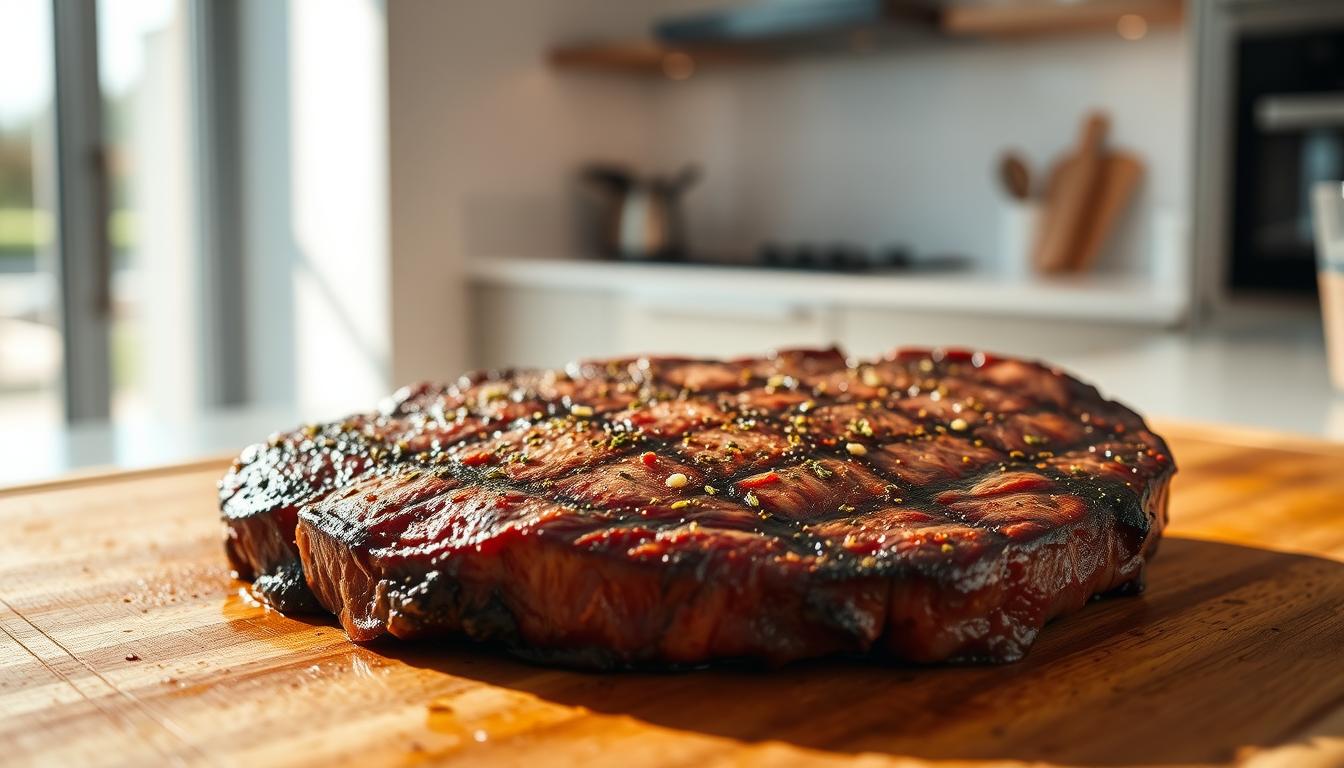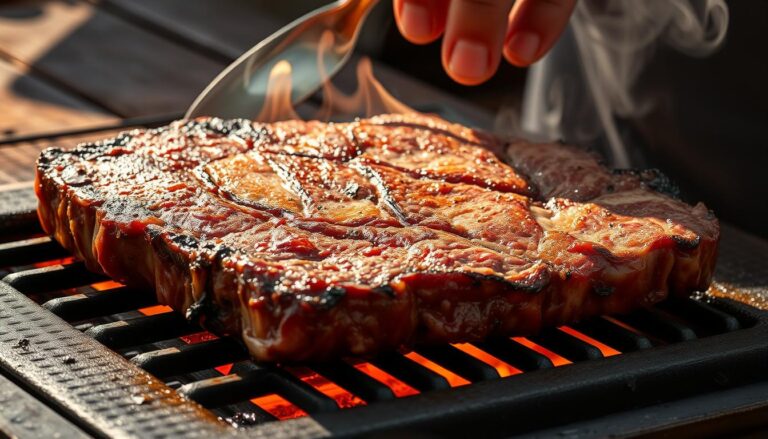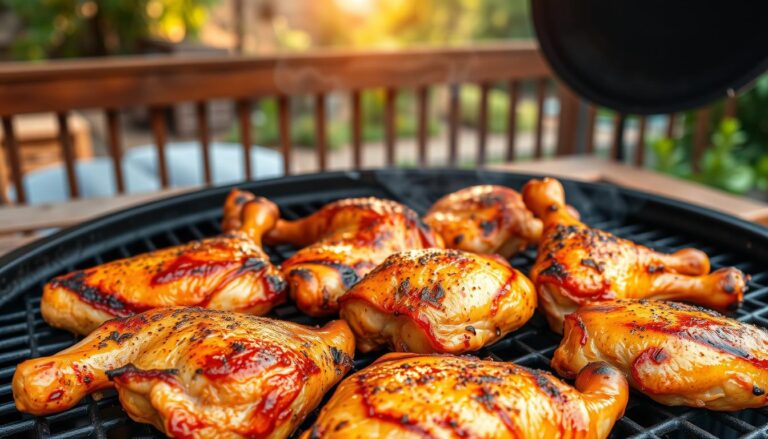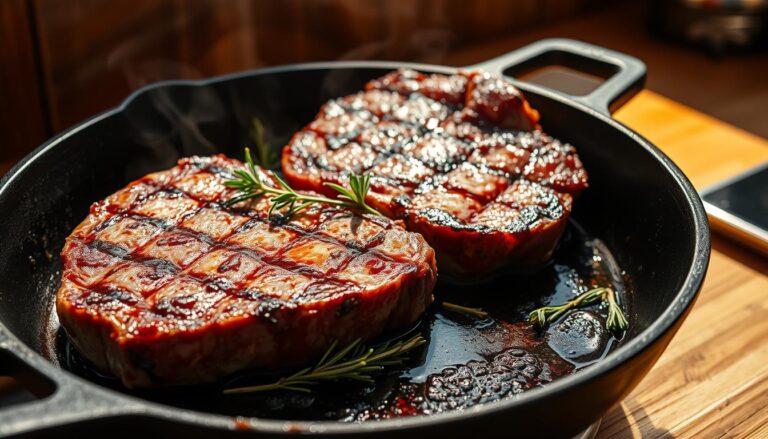Step-by-Step Guide to Cooking Beef Steaks: From Grill to Plate with Flavor
The sizzle of a perfect steak on the grill brings back summer memories. It’s more than cooking—it’s an art that turns simple ingredients into unforgettable meals.
Whether you love grilling or want to improve your cooking, mastering grilling techniques is key. This guide will show you how to make restaurant-quality steaks at home.
You’ll learn how to pick the best cut and get that perfect golden-brown crust. Discover the secrets to cooking steaks that will wow even the pickiest eaters. Get ready to enhance your cooking skills and change how you prepare beef.
Key Takeaways
- Learn professional-grade steak cooking techniques
- Understand the importance of meat selection and preparation
- Master temperature control for perfect doneness
- Discover flavor-enhancing seasoning methods
- Gain confidence in creating restaurant-quality steaks at home
Essential Equipment and Ingredients for Perfect Steak
Cooking a great steak begins with the right tools in your kitchen. You need more than just good meat. You need precise tools and careful preparation.
Choosing the Right Cooking Surface
Your cooking surface is key to a perfect steak. Top chefs suggest these surfaces:
- Cast iron skillet – keeps heat well
- Stainless steel griddle – cooks evenly
- Outdoor grill – adds nice char marks
- Flat-top electric griddle – controls temperature
Must-Have Tools for Steak Preparation
Upgrade your steak game with these tools:
- Digital meat thermometer
- Long-handled tongs
- Sharp boning knife
- Heavy-duty cutting board
- Meat resting rack
Quality Ingredients and Seasonings
Choosing the right seasonings can make a big difference. Simple salt and pepper can do wonders. But, trying out complex spice blends can open up new flavors.
Here are some top steak seasonings:
- Kosher salt
- Freshly ground black pepper
- Garlic powder
- Smoked paprika
- Dried herb blends
Good steak equipment and the right ingredients will make your cooking better.
Understanding Different Cuts of Beef Steaks
Choosing the right beef steak cuts can make your cooking better. Knowing the different types of steak helps you pick the best one for your taste and cooking style.
Each cut of beef steak has its own special qualities. These qualities affect the steak’s flavor, tenderness, and how it’s best cooked. Some cuts are great for grilling, while others are better with specific cooking methods.
- Ribeye: Known for rich marbling and intense flavor
- Filet Mignon: Extremely tender with minimal fat
- Sirloin: Lean cut with balanced meat texture
- Flat Iron: Increasingly popular for its rich taste
- Wagyu: Premium cut with exceptional marbling
| Steak Cut | Tenderness | Fat Content | Best Cooking Method |
|---|---|---|---|
| Ribeye | Medium | High | Grilling |
| Filet Mignon | Very High | Low | Pan-searing |
| Wagyu | High | Very High | Gentle cooking |
When looking at different steak types, think about what you like and your cooking skills. Some cuts need more skill to cook right, while others are easier for beginners.
Proper Steak Temperature and Preparation
Getting the perfect steak starts before it hits the grill. It’s all about handling, seasoning, and temperature control for a tasty outcome.
First, make sure your steak is at room temperature. Cold steaks cook unevenly, affecting taste and texture.
Room Temperature Guidelines
Take your steak out of the fridge 30-45 minutes before cooking. This step ensures even cooking and better flavor.
- Ensure even cooking
- Prevent tough, uneven meat
- Create a more consistent internal temperature
Seasoning Techniques
Seasoning boosts your steak’s taste. Start with kosher salt and black pepper for a simple yet effective flavor.
| Seasoning Method | Best Used For | Application Time |
|---|---|---|
| Salt and Pepper | All steak cuts | 30 minutes before cooking |
| Dry Rub | Thick cuts | 1-2 hours before cooking |
| Herb Blend | Ribeye and New York strips | Immediately before cooking |
Marinade Options and Timing
Marinating can change your steak’s taste and softness. The right cut needs the right marinating time:
- Flank steak: 2-4 hours
- Skirt steak: 1-2 hours
- Tough cuts: Up to 24 hours
Be careful with acid-based marinades. They can make meat too soft if marinated too long.
Delicious beef steak dishes to try this weekend
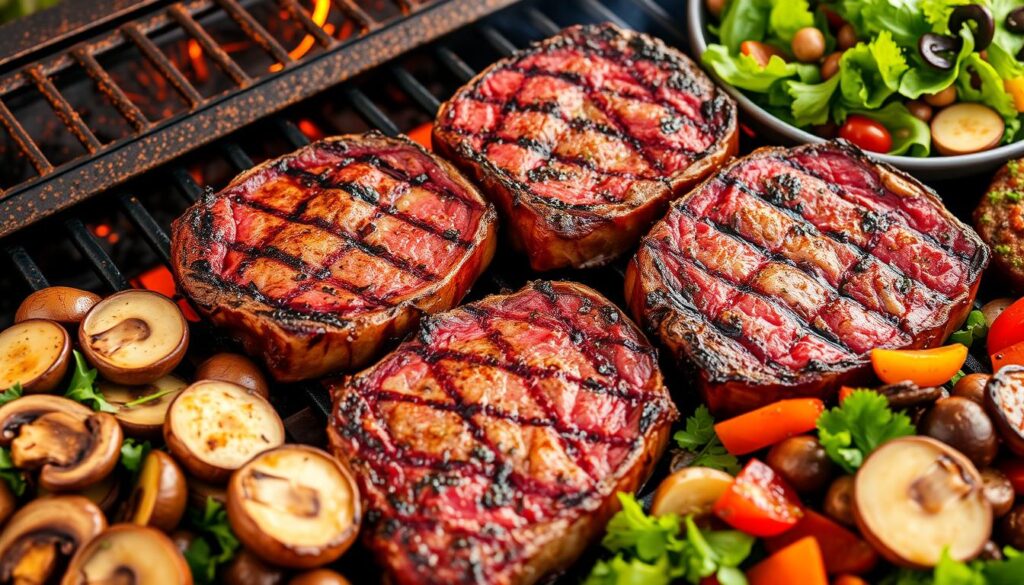
Want to make your weekend meals special? Try these tasty beef steak recipes. They’ll turn your cooking into a gourmet experience. Whether you’re a pro in the kitchen or just enjoy cooking on weekends, these ideas will wow your loved ones.
Here are some tasty steak dishes for the weekend that are simple to make:
- Flat Iron Steak with Chimichurri: This Argentine dish is full of flavor. Marinate the steak in olive oil, garlic, and herbs before grilling.
- Pepper-Crusted Ribeye: Make a beautiful crust with black and green peppercorns. Serve with a red wine sauce for a fancy touch.
- Asian-Inspired Flank Steak: Marinate in soy sauce, ginger, and sesame oil for a quick, tasty meal.
Adding the right wine and sides can make your steak dishes even better. Here are some pairing ideas:
| Steak Cut | Wine Pairing | Recommended Side |
|---|---|---|
| Flat Iron | Malbec | Roasted Vegetables |
| Ribeye | Cabernet Sauvignon | Garlic Mashed Potatoes |
| Flank Steak | Pinot Noir | Asian Slaw |
Remember, let your steak rest for 5-10 minutes after cooking. This ensures it stays juicy and flavorful. These weekend steak dishes will quickly become your favorites!
Mastering the Perfect Sear Technique
To make a steak like a pro, you need to learn about steak searing. A great sear turns a simple steak into a feast. It makes the outside crispy and the inside juicy.
Getting a perfect sear is all about the right cooking tricks. These tricks make your steak go from good to amazing. Let’s look at what makes a steak crust truly special.
Creating the Perfect Crust
For a top-notch steak crust, follow these simple steps:
- Use a heavy-bottomed pan or cast-iron skillet
- Make sure the pan is super hot
- Pat the steak dry before cooking
- Choose oils that don’t burn easily, like avocado or grapeseed
Temperature Control Methods
Controlling the heat is key for a great sear. Each cooking surface needs a different approach:
| Cooking Surface | Ideal Temperature | Recommended Technique |
|---|---|---|
| Cast Iron Skillet | 425-450°F | Preheat for 5-7 minutes |
| Outdoor Grill | 500-550°F | Direct high-heat zone |
| Stainless Steel Pan | 400-425°F | Medium-high heat with oil |
Timing Your Flip
Flipping your steak at the right time is important. For most steaks, flip once for a golden crust. Aim for 3-4 minutes per side for a 1-inch steak, depending on how done you like it.
Be patient to master steak searing. With practice, you’ll make steaks like a pro at home.
Internal Temperature Guide for Different Doneness Levels
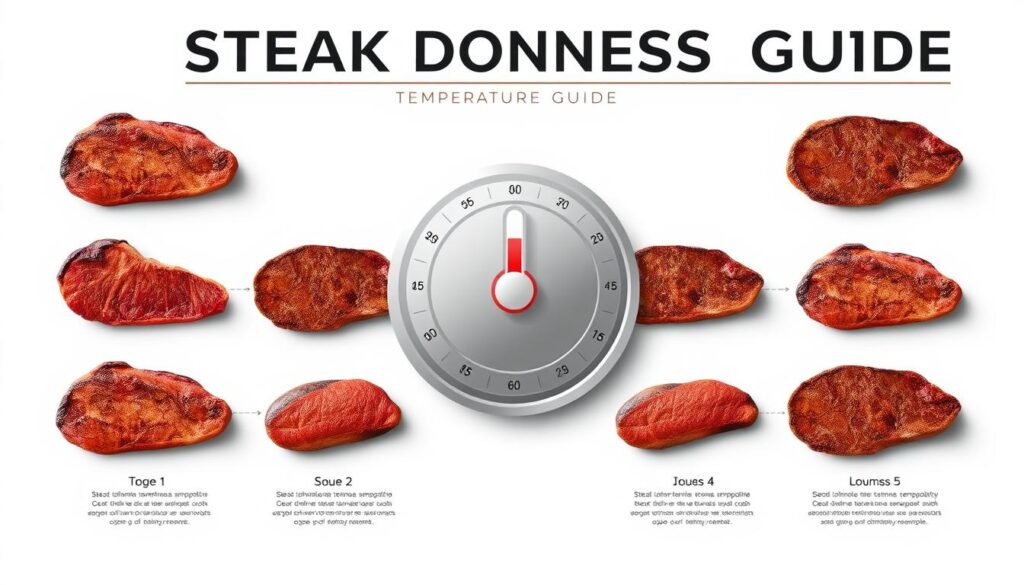
Achieving the perfect steak doneness requires precision and a reliable meat thermometer. It’s key to turn a good steak into an exceptional meal.
Mastering steak doneness means knowing the exact internal temperatures for each level. A meat thermometer is your most valuable tool in this journey.
- Rare: 125°F (52°C) – Cool red center, soft texture
- Medium Rare: 135°F (57°C) – Warm red center, most recommended
- Medium: 145°F (63°C) – Pink center with some firmness
- Medium Well: 150°F (66°C) – Slight pink center
- Well Done: 160°F (71°C) – No pink, fully cooked through
Pro tip: Always remove your steak from heat 5 degrees below your target temperature. Carryover cooking will continue to raise the internal temperature during resting, ensuring perfect steak doneness every time.
When using a meat thermometer, insert it into the thickest part of the steak, avoiding fat or bone. This guarantees an accurate reading of cooking temperatures and helps you achieve your desired level of doneness.
Essential Resting Time and Why It Matters
Steak resting is key to turning a simple cut of meat into a gourmet dish. After cooking, the steak needs time to spread out its juices. This makes the steak more flavorful and tender.
Not letting the steak rest can make it dry and less tasty. When you take the steak off the heat, the juices are close to the surface. Cutting too soon lets these juices spill out, making the meat less juicy and less tasty.
Optimal Resting Periods
The right resting time varies based on the steak’s size and thickness. Here are some tips for perfect resting:
- Thin steaks (under 1 inch): Rest for 5-7 minutes
- Medium steaks (1-1.5 inches): Rest for 7-10 minutes
- Thick steaks (over 1.5 inches): Rest for 10-15 minutes
Proper Resting Techniques
To keep the steak juicy and warm, follow these steps:
- Move the cooked steak to a warm plate
- Loosely cover with aluminum foil
- Keep it away from drafts
- Don’t cut or pierce the meat
Pro tip: A warm plate helps keep the steak’s temperature during rest, keeping your meal hot and delicious.
Complementary Sauces and Seasonings

To make your steak truly special, you need to know about flavor enhancers. Steak sauces and seasonings can turn a great steak into a work of art. The trick is to pick flavors that match the meat’s natural taste.
Steak sauces come in many flavors that can make your meal better. Here are some top choices for seasoning pairings:
- Béarnaise Sauce: A rich, buttery sauce with tarragon that perfectly complements tender beef
- Peppercorn Sauce: A bold, spicy option that adds depth to your steak
- Red Wine Reduction: A sophisticated sauce that brings out the meat’s natural flavors
Choosing the right flavor enhancers depends on your steak’s cut and how it’s cooked. Different sauces suit different cooking methods and meat types.
| Steak Cut | Recommended Sauce | Flavor Profile |
|---|---|---|
| Ribeye | Chimichurri | Herbal and Tangy |
| Filet Mignon | Béarnaise | Creamy and Delicate |
| New York Strip | Peppercorn | Bold and Spicy |
Making your own steak sauces lets you try new flavor mixes. Begin with simple things like butter, herbs, and stock. Then, add more to make it richer. The best sauce should boost the steak’s flavor, not hide it.
Plating and Presentation Tips
Turning your steak into a masterpiece is more than cooking. It’s about the art of plating. This art makes your meal look like it’s from a restaurant.
Food presentation is not just about looks. It’s about creating a sensory experience. This experience starts with what you see before you take a bite. The right presentation can make your steak unforgettable.
Garnishing Techniques to Enhance Visual Appeal
Here are some tips to make your steak look amazing:
- Sprinkle fresh herbs like thyme or rosemary around the plate
- Use microgreens for a touch of elegance
- Add a small drizzle of herb-infused oil
- Include colorful vegetable accents
Perfect Side Dish Pairings
Choose sides that match your steak’s flavor and look:
| Steak Type | Recommended Side Dishes |
|---|---|
| Ribeye | Roasted garlic mashed potatoes |
| Filet Mignon | Asparagus with lemon zest |
| New York Strip | Grilled seasonal vegetables |
The goal of steak plating is to create a balanced, stunning dish. It should show off your cooking skills. Try different colors, textures, and arrangements to make your meal stand out.
Conclusion
Learning to cook beef is an art that grows with time and love. You’ve started your steak journey by learning key techniques and choosing the best ingredients. You’ve also learned how to grill and sear like a pro.
Steak cooking is more than just following recipes. It’s about developing your own style. You’ve learned how to pick the right cut and control the temperature. These skills will make your weekend cooking better.
Now, it’s time to start your steak mastery. Try different cuts and seasonings. Don’t worry about mistakes. Cooking is all about learning and trying new things.
Share your cooking with friends and family. See how your skills improve with each meal. Your kitchen is now a place where you can make amazing steak dishes.
Enjoy cooking and trust your instincts. The delicious meals you make will impress everyone. Your kitchen is ready to become your own steakhouse.

